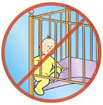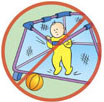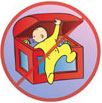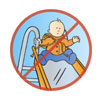Check for product recalls
Cribs
Car seats and Baby carriers
Baby bath seats
High chairs
Strollers
Change tables
Blind and curtain cords
Baby walker with wheels
Baby gates
Playpens
Bunk beds
Toy box and chests
Drawstrings on children's clothing
Always check for product recalls
If you care for young children, you probably have many products. But you may not know that some products may seriously hurt a child. Use this booklet to check products:
- in your home
- in daycares
- in grandparents, relatives and friends homes
- when you shop for children's products (new or second hand) if someone gives or lends you a product
This booklet contains only some details about product safety. For more information on product safety, contact Safe Kids Canada at 1-888- SAFE-TIPS (723-3847) or www.safekidscanada.ca.
Check for product recalls
Sometimes a product is recalled by the company that made it. This usually happens if there is a serious problem with the product that makes it dangerous. Even if the product is fairly new, always check to make sure that it has not been recalled. Some recalls are very recent. You can check on product recalls by calling the company or visiting their Web site. If you buy a new product, be sure to fill in the product registration card and send it back right away. This will help the company contact you if the product is recalled.
Top
Cribs 
Cribs made before 1986 are dangerous. Some children have died in older cribs when the part supporting the mattress fell down and they became entrapped. Other dies when their head got caught between the crib bars. Cribs bars should be no more than 6 centimeter (2 3/8 inches) apart. The ruler on the side of this brochure can be used to check the distance between the crib bars.
How to choose a safe crib
- Do not use a crib made before 1986. Check the label on your child's crib to see how old it is. If your crib does not have a label, or is homemade, it may not be safe to use.
- Be sure that the space between crib bars is no more than 6 centimetres or 2-3/8 inches.
- Choose a crib where the part supporting the mattress is attached permanently to the crib frame. It should not be attached by S-shaped or Z-shaped hooks.
- Do not use a crib that has any corner posts that could catch on your child's clothing.
- Do not buy a crib that has loose, missing or broken parts.
- Make sure the mattress in the crib is firm and no more than 15 centimetres or 6 inches thick.
- Make sure the mattress fits tightly against all 4 sides of the crib. If you can fit more than one finger between the mattress and each side of the crib, the mattress is too small. Babies can get wedged between the mattress and the side of the crib.
Safety tips for using cribs
- Always lock the sides of the crib in the upright position after placing your baby in it.
- Keep your baby's crib away from windows, curtain or blind cords. Children can fall out of the window or get caught in curtain or blind cords.
- Do not put large stuffed toys, pillows, bumper pads and thick comforters into your baby's crib. These items can suffocate your baby.
- Make sure your baby does not have a bib, necklace, or anything tied around his or her neck when in the crib. These items could get caught on parts of the crib and strangle your baby.
- As soon as your baby can push up on his hands or knees, remove toys strung across the crib. Your baby can become caught in these toys and strangle.
- When your child is about 90 centimetres or 35 inches tall, he or she can climb out of the crib. This is the time to move your child from the crib into a low bed.
Top
Car seats
Using safely in the car
- Do not use a second-hand car seat unless you have the instructions and know that it has not been in a crash or been recalled. It should also have all the parts and a label that says it meets Canadian Motor Vehicle Safety Standards.
- Do not use a car seat that is more than 10 years old. The plastics start to wear out. Check the car seat label to find out when it was made. Also check the instructions for your car seat. Some car seats are safe for only 6 years.
- Always use the right kind of car seat for your child. Make sure you use it correctly.
Using safely at home
- Keep a car seat on the floor, rather than a table or counter. Babies can rock themselves right off the edge or be knocked over.
- Car seats can tip over easily. Do not leave them on soft surfaces like a bed or sofa. Your baby could fall over and be suffocated.
- Never use a car seat as a crib. Children have died when they slipped down and became tangled in the straps.
- Babies sometimes fall asleep in their infant car seat while they are in the car. If you carry your sleeping child indoors in his or her infant car seat, keep the straps on and watch your child closely until you move him or her to the crib.
Baby carriers
- Always use the safety straps when using a baby carrier.
- Do not leave your baby unattended in the baby carrier for long periods of time.
- Never use a baby carrier in a car unless it is labeled for that purpose.
- Keep a baby carrier on the floor, rather than a table or counter. Babies can rock themselves right off the edge or be knocked over.
- Baby carriers can tip over easily. Do not leave them on soft surfaces like a bed or sofa. Your baby could fall over and be suffocated.
Top
Baby bath seats
Many parents like to use a bath seat because it keeps their hands free to wash the baby. But  babies left alone in bath seats have drowned. It is never safe to leave a baby alone in the bath, not even for a few seconds. Bath seats are not safety devices. babies left alone in bath seats have drowned. It is never safe to leave a baby alone in the bath, not even for a few seconds. Bath seats are not safety devices.
- Some babies in bath seats almost drowned even when their parents were in the bathroom. This is because the suction cups on the bottom of the bath seats did not stick properly to the bathtubs. The babies fell over into the water.
- Do not use a baby bath seat. It is not a product that you need to look after your baby. It is not worth taking the risk.
Top
High chairs
Most children are hurt by falling from high chairs when the safety straps are not used. Children can  also slide down and get their heads caught between the tray and the chair if they are not wearing their safety straps. also slide down and get their heads caught between the tray and the chair if they are not wearing their safety straps.
How to choose a safe high chair
- Make sure that the high chair has a wide base that prevents the chair from tipping over.
- Choose a high chair that has safety straps that include a strap for the waist and a crotch strap that fits between your child's legs.
- Make sure folding high chairs lock securely when set up.
Safety tips for high chairs
- Always use safety straps including the crotch strap to keep your child in the chair. The feeding tray will not keep your child from climbing out or sliding down under the tray.
- Make sure you lock the tray into place.
- Watch your child closely when he or she is in the high chair.
- Teach your child not to stand up in the high chair. Standing in the chair could cause the high chair to topple over.
- Keep your child's high chair away from tables, counters or walls that your child could push against with his or her legs and fall over.
- Keep your child's high chair away from windows, blind cords, stoves or other electrical appliances.Do not let older children climb onto the high chair while a baby is in it. The high chair could tip over.
Top
Strollers
Many children are injured when they fall out of strollers because the safety straps are not used. Children can also slide down and get their heads caught in the leg opening if they are not wearing their safety straps.
How to choose a safe stroller
- Choose a stroller that is sturdy and that is right for your child's weight. Check the weight recommendations provided by the company.
- Make sure that the stroller brakes work properly and the wheels are attached firmly.
- Choose a stroller that has safety straps that include a strap for the waist and a crotch strap that fits between your child's legs.
- Make sure the stroller has locks to stop it from folding when your baby is in it. Look for a stroller with a basket underneath to carry bags or heavy purses.
Safety tips for using strollers
- Always use the safety straps when your child is in the stroller.
- Use stroller brakes every time you stop your stroller.
- Do not leave your child unattended in a stroller.
- Do not hang heavy purses or other bags on strollers. This may cause the stroller to tip over.
Top
Change tables
Many babies are hurt when they roll off change tables. A baby can roll over and fall from a change table in the few seconds it takes to reach for a diaper.
How to choose a safe change table
- Choose a change table that has a sturdy base to keep it from tipping.
- Choose a change table that has straps or guard rails that will help keep your baby from rolling off the table.
- Change tables with drawers or shelves make it easy to reach items like towels and diapers without leaving the baby unattended.
Safety tips for using change tables
- Never leave your child alone on a change table even if he or she is strapped in. Keep everything you need right beside you. If you need to get something, take your child with you.
Top
Blind and curtain cords
Be sure to use window blinds and curtains safely. Children have died when their heads got caught in  the cords. Most young children who died could reach the cords from their cribs. the cords. Most young children who died could reach the cords from their cribs.
Safety tips for using blind and curtain cords
- Keep your child's crib or bed and other furniture away from the window.
- Do not leave curtain or blind cords hanging. Keep pull cords out of your child's reach. To keep your kids safe:
- Tie the pull cords up using a clip, clothespin, or a big twist tie.
- Wrap the cord around a cleat that is attached to the wall close to the top of the curtains or blinds.
- If there is a loop in the cord, cut the cord short and put plastic tassels at the end of the cord. Vertical blinds and some curtains need a looped pull cord to work. Do not cut this loop. Instead, wrap it around a cleat on the wall.
- Also check the inside cords that hold blind slats in place. If you can pull out a loop of the inside cords longer than 15 centimetres or 6 inches, the blind is not safe. Throw it out.
Baby walkers with wheels
Wheeled baby walkers were banned in Canada in 2004 because they cause many serious injuries  to children. They are not available for sale in Canada and should not be used. to children. They are not available for sale in Canada and should not be used.
- Baby walkers will not help your child to walk and will put your child at risk for serious injuries such as falls down stairs.
- Gates at the top of the stairs will not always prevent falls in baby walkers. Many falls have occurred when baby gates were left open.
- Most walker injuries happen when a parent is close by. Babies can move very quickly in a walker and can reach items on a table or counter. Babies have been scalded by pulling hot food or drinks onto themselves.
Baby gates 
Baby gates are used at the top or bottom of stairs or in open doorways to prevent toddlers from falling downstairs or entering unsafe areas. There are two basic types of gates-pressure gates and hardware-mounted gates. Pressure gates stay in place by using a bar that fits against the doorframe with pressure. Pressure gates can be easily moved from one place to another. Hardware-mounted gates are attached permanently to the wall or doorframe by screws.
How to choose a safe baby gate
- Check the age of the baby gate. Baby gates made before 1990 are dangerous. Do not use them. These gates usually have large diamond or "V" shaped openings that could trap your child's head or neck.
- Do not use a baby gate with any openings that could trap your child's head or neck.
Safety tips for using baby gates
- Use the correct type of baby gate at the top of stairs. Any baby gate at the top of stairs must be fastened to the wall with screws. Do not use a pressure gate. If your child leans on a pressure gate at the top of stairs, it could fall over and your child would fall down the stairs.
- Pressure gates should be installed with the pressure bar on the side away from your child. This will prevent your child from standing on the pressure bar to climb over the gate.
- When installing baby gates, there should be no more than 5 centimetres or 2 inches space between the floor and the bottom of the gate. This will prevent your child from slipping underneath.
- Baby gates should be taken down once your child reaches age 2 or when the top of the gate is at his or her chin level. Teach young children how to use stairs safely and supervise them while they learn.
- Teach an older sibling to always lock the gate after he or she uses it.
Playpens
Playpens, although providing a way to separate your child from hazards around your home, may  contain hazards of its own. contain hazards of its own.
- Playpens should have mesh sides the size of mosquito type netting. Larger mesh allows button, hooks or strings to be entangled and can cause strangulation.
- Always make sure the sides of the playpen are up and locked into place. Babies can suffocate if they become trapped in the space between the mattress and the mesh.
- Remove toys or change tables from across the top of the playpen when your child starts to stand. These items can fall on top of your child or can be used to climb out.
- Children should be closely supervised when in a playpen.
Top
Bunk beds 
Some young children have died using bunk beds that do not meet safety standards. Their heads were caught in the gaps between the guard rails. Others have suffocated when they slipped between the mattress and the guard rail, or between the mattress and the wall. Children have also been badly injured in falls from the top bunk. Most of these children were under age 6.
How to choose a safe bunk bed
- Check your bunk bed for a label that says it meets American safety standards. The label should say, "ASTM F-1427-96 and 16CFR, Parts 1213, 1500 and 1513". Ask before you buy. There are no laws in Canada to stop stores from selling unsafe bunk beds.
- Make sure that the top bunk has a continuous guard rail on all 4 sides of the bed. The guard rail should be at least 13 centimetres or 5 inches above the mattress surface.
- Check the gap between the guard rail and the upper edge of the bed framek. The gap should be no more than 9 centimetres or 3-� inches.
- The mattress in the bunk bed should fit tightly against all 4 sides of the bed. There should be no gaps between the mattress and the sides of the bed.
- Make sure that the ladder is attached securely to the bed and will not slip when your child climbs on it.
- Make sure that the part supporting the top mattress is attached securely to the bed frame. This will prevent it from collapsing and trapping your child on the lower bunk.
Safety tips for using bunk beds
- Do not allow children under age 6 to sleep or play on the top bunk.
- Do not allow more than one child at a time on the top bunk.
- Teach children to always use the ladder to get up or down from the top bunk.
Top
Toy box and chests 
Children have been badly hurt when toy box lids fell on their heads or necks. Some children have died when they became trapped inside a toy chest and could not breathe.
How to choose a safe toy box or chest
- Choose a toy box or chest that has a lightweight lid and a good hinge that stops the lid from slamming down. Remove the lid if it does not have this kind of hinge.
- Make sure that the toy box or chest has holes in the side or front so that air can get inside.
Top
Drawstrings on children's clothing
- Children have been strangled when the drawstrings on the hood or neck of their clothing got
 caught on playground equipment, fences or other things. caught on playground equipment, fences or other things.
- Remove all drawstrings from the head and neck area of children's clothing.
- When buying children's shirt or jackets choose items that do not use drawstrings to close. Instead, choose items that use elastics, buttons, velcro or snaps.
Remember, always check for product recalls!
Products are recalled because the company has found something wrong that could be dangerous. To check for recalls on products, contact Consumer Product Safety, Health Canada at www.healthcanada.gc.ca/cps or 1-866-662-0666. If you have concerns about a specific product, contact the manufacturer by phone or check their website.
| Page published on 2006-07-26 |
|






 babies left alone in bath seats have drowned. It is never safe to leave a baby alone in the bath, not even for a few seconds. Bath seats are not safety devices.
babies left alone in bath seats have drowned. It is never safe to leave a baby alone in the bath, not even for a few seconds. Bath seats are not safety devices. also slide down and get their heads caught between the tray and the chair if they are not wearing their safety straps.
also slide down and get their heads caught between the tray and the chair if they are not wearing their safety straps.  the cords. Most young children who died could reach the cords from their cribs.
the cords. Most young children who died could reach the cords from their cribs.  to children. They are not available for sale in Canada and should not be used.
to children. They are not available for sale in Canada and should not be used.
 contain hazards of its own.
contain hazards of its own.

 caught on playground equipment, fences or other things.
caught on playground equipment, fences or other things.